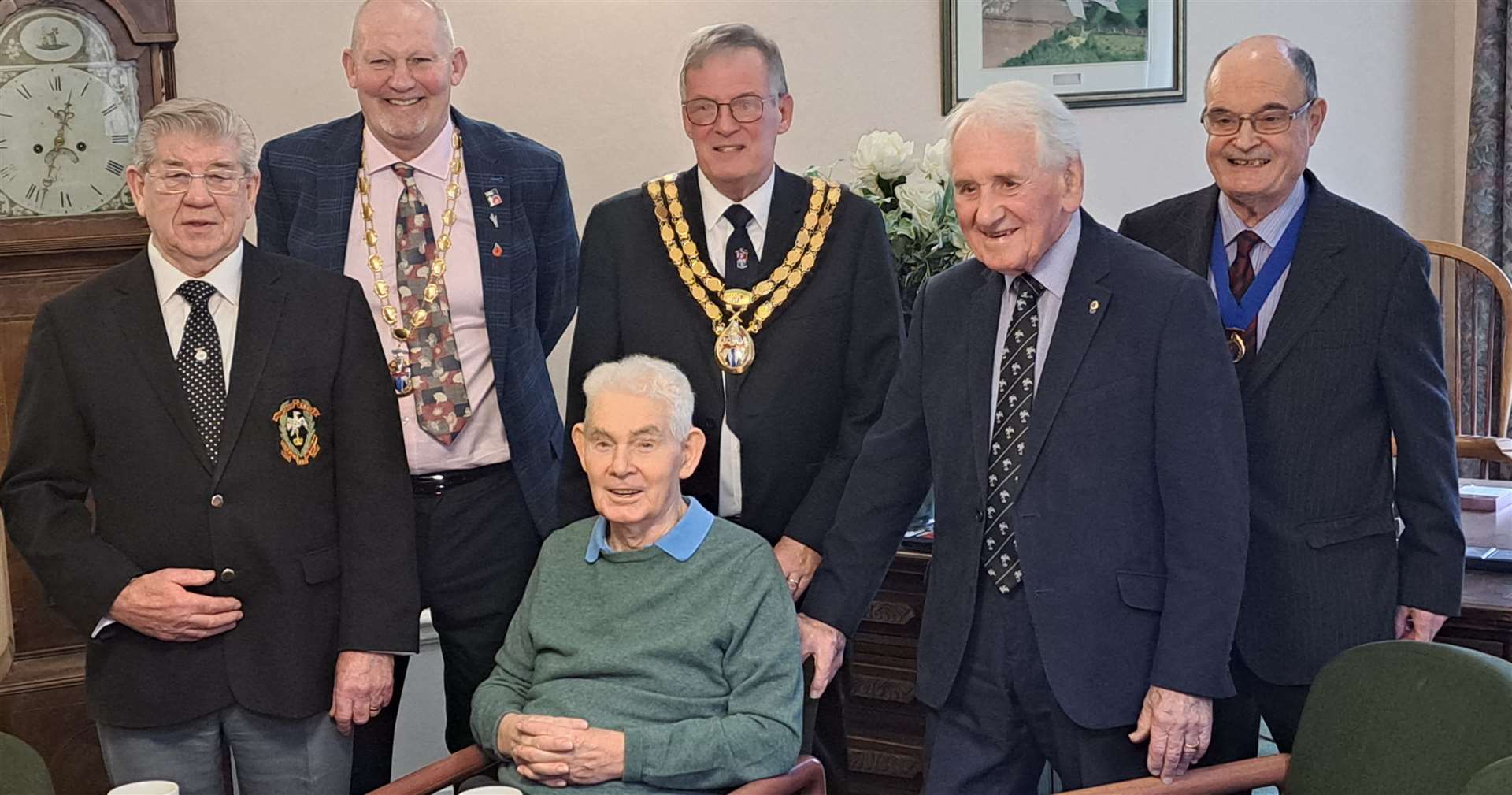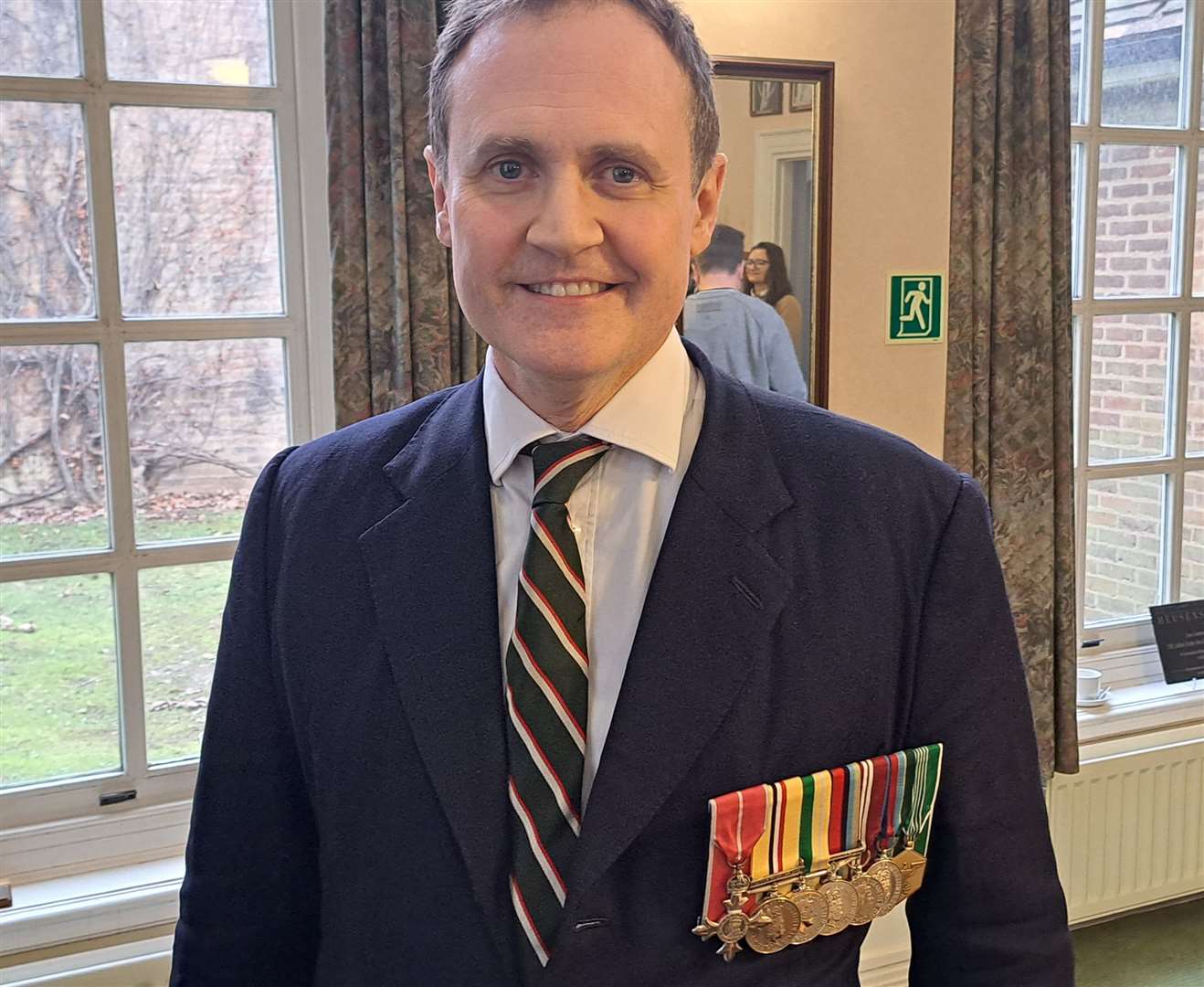Nuclear test veterans get a medal 65 years after their service on Christmas Island during H-bomb blasts
Published: 20:11, 12 January 2024
Updated: 11:21, 13 January 2024
It has taken 65 years or more, but three veterans of Britain’s Nuclear Test programme of the 1950s have finally received the medals they deserve.
All three Kent veterans served on Christmas Island – now known as Kiritimati – in the Pacific Ocean in the late 1950s when Britain was developing its nuclear deterrent.

All three lived through nuclear test explosions detonated a short distance from their bases and they watched the resulting mushroom clouds balloon before them.
Today, their service was finally recognised as the Mayor of Tonbridge and Malling, Cllr James Lark, presented them with the Nuclear Test Veteran’s Medal in a ceremony at the council offices in Kings Hill which was attended by MP Tom Tugendhat, himself a former Army veteran.
The Mayor told them: “Brave, doesn’t even begin to cover what you did. Hats off to you for your service.
“We who haven't served are eternally grateful. It is because of gentlemen like you that we live today in a free world.
Mr Tugendhat said: “I’m very proud that this government has finally recognised these veterans.

“What they did is something that happened many years ago, and is often forgotten by many, but the reality is that the benefits are still very much with us today.
“The United Kingdom is safe today because we are able to defend ourselves, because we were able to develop the technology that these veterans were so important in helping to provide. Since their days, the nuclear deterrent has been working, keeping this country safe.
He told them: “What you did has helped keep Britain safe and free ever since the Second World War.”
Ian Kury, now 86, was one of the first to be sent to the remote testing site.
He was part of the advance party from the Royal Electrical and Mechanical Engineers (REME) sent there in 1957 for the purpose of setting up the site and establishing an airfield.
A three-year regular soldier, it was his first trip overseas, and he recalled how he and other members of the No2 Special Engineers squad were told nothing of where they were going or why, until they landed in Honolulu, when an American serviceman casually gave them the lowdown.
Corporal Kury, as he then was, served on Christmas Island for 11 months, and was there for Britain’s first test explosion on November 8, 1957, when the 1.8 megaton Grapple X bomb was detonated.
The bomb was 120 times more powerful than the Little Boy bomb dropped on Hiroshima during the Second World War.
He said: “We were told to sit with our backs towards the blast and to fold our arms over our eyes.
“There was a flash of heat across our bare backs, like sitting too close to the electric fire.
“Then we were told we could stand up, turn round and watch the mushroom cloud.
“But the shock wave and noise came a little after. We fell to the ground and the coconut trees bent in the blast and coconuts flew everywhere.
“It was one hell of an explosion.”
Mr Kury and his fellow soldiers had no protective gear and were given no warnings about radiation sickness.
Fortunately, unlike many of his colleagues, Mr Kury did not develop any symptoms and on leaving the Army was able to pursue a successful career in the city.
He moved to Tonbridge in 1964 and now lives in Hildenborough.
Ray Porter joined the Army as a boy soldier in 1951. Born in Rochester, his service with the Royal Engineers had already taken him into combat in Suez and in Cyprus, before he was shipped out to Christmas Island in 1958.
He said: “I was part of the Foward Operating Squad and I was put in charge of the power station that generated the power for the RAF radar site.”
He was on the island for 355 days, during which time he endured the second H-bomb test and four smaller atom bomb tests.
Like Mr Kury, he recalled being told to sit with his back to the blast and to cover his eyes.
He said: “We were all just dressed in shorts and boots.
He said: “I remember first the flash and then the blast that knocked us head over heels, even though the bomb was detonated 30 miles away.”
He said they were all completely ignorant of the possibility of radiation poisoning. He said: “We just thought it was a great adventure!
“I was lucky and didn’t suffer any ill effects, but I think it depended on what your job was.
“Some of the RAF boys were ordered to fly over the site, and afterwards some men were just given the task of washing the radioactive dust of the planes, with no protection whatsoever.”
Despite the dangers he faced, Mr Porter looks back on his service days with nostalgia.
He said: “You have to remember that in 1950s’ Britain, almost no one went abroad. I didn’t take my first foreign holiday as a civilian until the 1970s. But with the Army I went to all sorts of places.”
Mr Porter is now 88 and lives in the Avery Rivermere Care Home in Sevenoaks.
Terry Quinlan was one of the less fortunate ones. He was an 18-year-old National Serviceman.
He was on the island for that first Grapple X blast and still there for four others.
Like the other veterans, he recalls being ordered to sit on the beach and cover his eyes.
When the flash came, he said he could see the bones in his hands like in an X-ray.
He was also struck in the throat by a piece of shrapnel thrown up by the blast as tents and trees were ripped up.
Two weeks later, Mr Quinlan was in the sick bay, suffering the effects of radiation exposure.
He had his first operation to remove a cancer tumour when he was just 24 and has been plagued with health problems ever since – problems that for some have continued into the next generation.
Research has shown that the children of test veterans were 10 times more likely to be born with birth defects or suffer sterility later in life than the average in the general population.
Although nuclear weapons were a relatively new invention, the dangers of radiation had first been made public decades before by Marie Curie, the famous French scientist, who had herself died of radiation poisoning in 1934.
Serving with the Royal Army Service Corps, Mr Quinlan's job was to drive huge trucks delivering supplies and materials all around the island – including construction materials for the bomb shelters for the scientists' equipment erected near to the test site on the southern corner of the Pacific Ocean atoll.
He recalled how trucks, boats and even two tanks were deliberately left at varying distances from point zero to see what the effect of the explosion would be on them.
After the bomb blasts, he and his comrades – dressed under the blistering tropical sun usually only in their khaki shorts – sometimes had to drive the boffins from the Atomic Weapons Research Establishment to their forward bases to carry out their tests.
No one ever suggested we also needed protection
He said: "They would wear full protective gear and masks, while we were wearing next to nothing. No one ever suggested we also needed protection."
Mr Quinlan, 84, from Leybourne, was one of the figures in the campaign to have the sacrifices of the test veterans recognised with a medal, speaking at conferences organised by the British Nuclear Test Veterans Association (BNTVA) and by LABRATS (Legacy of the Atomic Bomb, Recognition for Atomic Test Veterans).
He said: “Too many of my colleagues suffered and died well before their time.
“At last there is some recognition.”
Some 22,000 servicemen from all three forces were involved in the test programme.
More by this author
Alan Smith